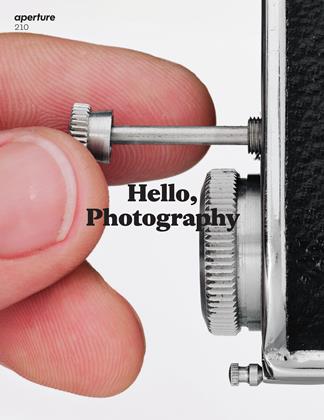Anouk Kruithof
Lesley A. Martin
Anouk Kruithof works with photography: she works through photography, around photography. The stand-alone image is rarely, if ever, the point. More critical are the events that result in photographs —actions that lead to photographs, which lead to installations, books, and videos; projects like Lang Zal Ze Leven/ Happy Birthday to You; Playing Borders: This Contemporary State of Mind; and Untitled (I've Taken Too Many Photos/ I've Never Taken a Photo).
Lang Zal Ze Leven (2011) was created during an artist’s residency at a progressive psychiatric hospital in Den Dolder, Netherlands. During her stay, Kruithof interviewed a group of patients about what they wanted for their birthdays and did her best to fulfill those wishes, including baking each of them a cake featuring an edible printedfrosting portrait of the recipient. Kruithof photographed her interactions with the group, and each of the patients participated in creating collages from this material. The resulting collaborative works, incorporating snippets from conversations as well as images, form the core of a book and subsequent installations. The foundation of the piece is consciously transactional—the photographs would not exist without the artist’s interaction with the patients; the interaction itself may not have happened without the intention to document it. Photography acts as a connective tissue, a binding agent that also provides a record of these individuals and their birthday wishes, and as a means for Kruithof to explore the fine lines between compulsive, “abnormal” psychologies and those considered “normal.”
Another series, Untitled (I've Taken Too Many Photos/Tve Never Taken a Photo) (2012), offers an experiment in call and response between photographer and viewer. In preparation for a show at the Festival International de Mode et de Photographie in Hyères, France, Kruithof sought someone in her adopted Brooklyn neighborhood who had ostensibly never taken a photograph. A young man named Harrison was enlisted to select images for an installation of Kruithof’s work, and determined as well the size of each print in the final presentation. The point of this exercise was to find a person who might bring a fresh, unjaded perspective to an archive of three hundred images, conflating the role of curator and viewer and destabilizing the notion of the artist as an auteur fully in command of every tiny detail of creation. Further inverting the traditional logic of exhibition making, eighty selected images made by Harrison were installed on the ceiling, with viewers asked to experience the exhibition via mirrors, much as tourists are given mirrors for better viewing of frescos on the ceilings of Venetian cathedrals.
The installation turns viewers into performers, a role played by former office workers in Playing Borders: This Contemporary State of Mind, a series Kruithof began in 2008 at the site of an abandoned office building. The improvised performances and interventions in the space give shape to an absurdist commentary on the average workplace in the face of collapse. On one hand, Playing Borders is a document of today’s workforce and work sites; on the other hand, it’s a performance piece enacted amid a series of incongruous still lifes. Kruithof’s restlessness and disinterest in categories is reflected in both installations of the work (one of which took place in the emergency exit of the Nederlands Fotomuseum in Rotterdam) as well as in the subsequent book, a series of unbound spreads of various sizes.
The installations and publications that emerge from these and other of Kruithof’s projects underscore her interest in visceral, physically interactive experiences of the work as well as a commitment to pushing beyond the conventions prescribing the creation and display of a body of photographs. In today’s socially mediated world, in which interpersonal interactions are frequently created, measured, and validated by the act of taking a picture, Kruithof generates her own network of action and photographic reaction.
Lesley A. Martin is the publisher of Aperture's books program and of the PhotoBook Review.
 View Full Issue
View Full Issue
More From This Issue
-
 Pictures
PicturesRevisiting The Garry Winogrand Archive
Spring 2013 By Philip-Lorca Dicorcia -
 Pictures
PicturesPostcards From America
Spring 2013 By Chris Boot -
 Pictures
PicturesAdam Broomberg & Oliver Chanarin
Spring 2013 By Brian Dillon -
 Pictures
PicturesAndrew Norman Wilson Scanops
Spring 2013 By Laurel Ptak -
 Pictures
PicturesPhil Chang Cache, Active
Spring 2013 By James Welling -
 Pictures
PicturesChristopher Williams
Spring 2013 By Matthew S. Witkovsky
Subscribers can unlock every article Aperture has ever published Subscribe Now
Lesley A. Martin
-
 Work And Process
Work And ProcessHara Mikiko Is As It
Winter 2007 By Lesley A. Martin -
 Mixing The Media
Mixing The MediaSam Falls Hyper-Conscious
Winter 2011 By Lesley A. Martin -
 Pictures
PicturesXiaobeilu
Spring 2014 By Lesley A. Martin -
 THE PHOTOBOOK REVIEW
THE PHOTOBOOK REVIEWIrma Boom Books for the Future
FALL 2022 By Lesley A. Martin -
 THE PHOTOBOOK REVIEW
THE PHOTOBOOK REVIEWHannah Darabi
SPRING 2023 By Lesley A. Martin -
 THE PHOTOBOOK REVIEW
THE PHOTOBOOK REVIEWMasahisa Fukase
FALL 2023 By Lesley A. Martin










